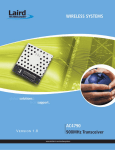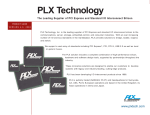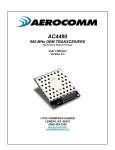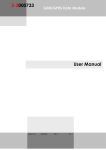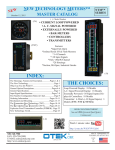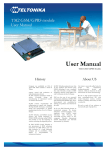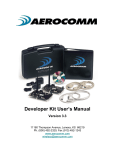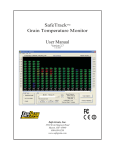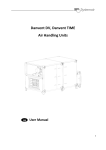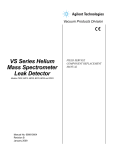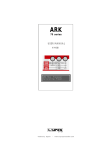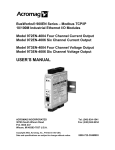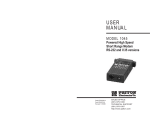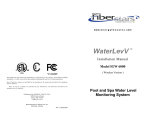Download AC4868 User`s Manual.book - Advanced Radio Telemetry
Transcript
VERSION 1.4 DOCUMENT INFORMATION Copyright © 2007 Laird Technologies, Inc. All rights reserved. The information contained in this manual and the accompanying software programs are copyrighted and all rights are reserved by Laird Technologies, Inc. Laird Technologies, Inc. reserves the right to make periodic modifications of this product without obligation to notify any person or entity of such revision. Copying, duplicating, selling, or otherwise distributing any part of this product or accompanying documentation/software without the prior consent of an authorized representative of Laird Technologies, Inc. is strictly prohibited. All brands and product names in this publication are registered trademarks or trademarks of their respective holders. This material is preliminary Information furnished by Laird Technologies in this specification is believed to be accurate. Devices sold by Laird Technologies are covered by the warranty and patent indemnification provisions appearing in its Terms of Sale only. Laird Technologies makes no warranty, express, statutory, and implied or by description, regarding the information set forth herein. Laird Technologies reserves the right to change specifications at any time and without notice. Laird Technologies’s products are intended for use in normal commercial and industrial applications. Applications requiring unusual environmental requirements such as military, medical life-support or life-sustaining equipment are specifically not recommended without additional testing for such application. Limited Warranty, Disclaimer, Limitation of Liability For a period of one (1) year from the date of purchase by the OEM customer, Laird Technologies warrants the OEM transceiver against defects in materials and workmanship. Laird Technologies will not honor this warranty (and this warranty will be automatically void) if there has been any (1) tampering, signs of tampering; 2) repair or attempt to repair by anyone other than an Laird Technologies authorized technician. This warranty does not cover and Laird Technologies will not be liable for, any damage or failure caused by misuse, abuse, acts of God, accidents, electrical irregularity, or other causes beyond Laird Technologies’s control, or claim by other than the original purchaser. In no event shall Laird Technologies be responsible or liable for any damages arising: From the use of product; From the loss of use, revenue or profit of the product; or As a result of any event, circumstance, action, or abuse beyond the control of Laird Technologies, whether such damages be direct, indirect, consequential, special or otherwise and whether such damages are incurred by the person to whom this warranty extends or third party. If, after inspection, Laird Technologies determines that there is a defect, Laird Technologies will repair or replace the OEM transceiver at their discretion. If the product is replaced, it may be a new or refurbished product. REVISION HISTORY Revision Description Version 1.0 8/29/05 - Initial Release Version Version 1.1 10/7/05 - Added Declaration of Conformity Version 1.2 5/29/07 - Updated serial interface section. response. Version 1.3 9/18/07 - Internal Release. Version 1.4 9/5/08- Updated to Laird Technologies branding. Clarified Duty Cycle calculations. Updated information on client to client communications. Corrected Read Temperature Command to a max of 0x50. Updated Minimum Baud Rate Corrected EEPROM write command Table of Contents AC4868-250 Transceiver Module 1 AC4868-250 features 1 Overview 1 Specifications 2 Pin Definitions 3 Electrical Specifications 4 Theory of Operation 5 RF Architecture 5 Modes of Operation 5 Duty Cycle Limitations 7 European regulations 7 Radio Operation 7 EEPROM Parameters 26 Dimensions 29 Mechanical Drawings 29 Ordering Information 30 Product Part Number Tree 30 Developer Kit Part Numbers 30 Compliancy Information 31 Agency Identification Numbers 31 Approved Antenna List 31 OEM Equipment Labeling Requirements 31 Country Restrictions 32 Country Notification 32 Declaration of Conformity 33 Appendix I - Sample Power Supply 34 Serial Interface 8 Serial Communications 8 OEM Host Data Rate 9 Serial Interface Baud Rate 9 Interface Timeout / RF Packet Size 10 Flow Control 10 Half Duplex / Full Duplex 11 System Timing & Latency 11 System Throughput 12 Software Interface 13 Networking 13 Range Refresh 13 Auto Config Parameters 13 Max Power 14 Timing Diagrams 15 AC4868-250 Timing Diagrams 15 Hardware Interface 17 Pin Definitions 17 Configuring the AC4868-250 19 AT Commands 20 Command Descriptions 22 Bill of Materials 34 Schematic 35 PCB Layout 35 Appendix II - 5V to 3.3V Levels 37 AC4868-250 T RANSCEIVER M ODULE 1 The compact AC4868-250 868MHz transceiver can replace miles of cable in harsh industrial environments. Using field-proven technology which needs no additional CE licensing in Europe, OEMs can easily make existing systems wireless with little or no RF expertise. AC4868-250 FEATURES NETWORKING AND SECURITY • • • • Drop-in replacement for AC4490 900 MHz & AC4424 2.4 GHz product families Generic I/O digital lines and integrated DAC/ADC functions Retries and Acknowledgements Low latency and high throughput EASY TO USE • Software selectable interface baud rates from 1200 bps to 57.6 kbps • Low cost, low power and small size ideal for high volume, portable and battery powered applications • All modules are qualified for Industrial temperatures (-40°C to 80°C) • Advanced configuration available using AT commands • Server/Client or peer-to-peer communication OVERVIEW The AC4868-250 is a member of Laird Technologies’s ConnexRF OEM transceiver family. The AC4868-250 is designed for integration into OEM systems operating under European ETSI regulations for the 868 - 870 MHz band. AC4868-250 transceivers provide an asynchronous TTL/RS-485 level serial interface for OEM Host communications. Communications include both system and configuration data. The Host supplies system data for transmission to other Host(s). Configuration data is stored in the on-board EEPROM. All synchronization and RF system data transmission/reception is performed by the transceiver. AC4868-250 transceivers can operate in a Point-to-Point, Point-to-Multipoint, or Peer-to-Peer architecture. The AC4868-250 utilizes a single channel synchronization allowing all radios to communicate with any radio in range. Optionally any radio can be configured as a Server to provide a synchronization beacon. This beacon is used be the Client radios to determine In Range status and for Auto Destination addressing. This document contains information about the hardware and software interface between an Laird Technologies AC4868-250 transceiver and an OEM Host. Information includes the theory of operation, specifications, interface definition, configuration information and mechanical drawings. The OEM is responsible for ensuring the final product meets all appropriate regulatory agency requirements listed herein before selling any product. Note: Unless mentioned specifically by name, the AC4868-250 modules will be referred to as the “radio” or “transceiver”. Individual naming is used to differentiate product specific features. The host (PC/Microcontroller/Any device to which the AC4868-250 module is connected) will be referred to as “OEM Host”. www.lairdtech.com 2 S PECIFICATIONS Table 1: AC4868-250 Specifications General 20 Pin Interface Connector Molex 87759-0030, mates with Samtec SMM-110-02-S-D RF Connector Telegartner J01341C0081, mates with any manufacturer’s MMCX style plug Antenna AC4868-250: MMCX Connector Serial Interface Data Rate Baud rates from 1200 bps to 57.6 kbps Power Consumption (typical) 10%TX 50%TX 54mA 138mA Channels Single Channel Security One byte System ID. 56-bit DES encryption key. Interface Buffer Size Input/Output:256 bytes each 100%TX 240mA 100%RX 36mA Pwr-Down Deep Sleep TBD 24mA Transceiver Frequency Band Europe 500 mW: 869.4 - 869.65 MHz RF Data Rate 19.2 kbps or 28.8 kbps dependent on interface baud rate RF Technology Single Frequency FSK Output Power Conducted (no antenna) 186mW typical Supply Voltage Pin 10 (uP power): 3.3 – 5.5V ±50mV ripple; draws ~30-50mA. Must be connected. Pin 11 (PA power): 3.3 ±3%, ±100mV ripple; draws most current. Must be connected. Sensitivity -103dBm typical @ 28.8kbps RF Data Rate EEPROM write cycles 20000 Hop period 53 ms Range, Line of Site (based on 2.5dBi gain antenna) Up to 15 km (9.3 miles) EIRP (2.5dBi gain antenna) 250mW typical Environmental Temperature (Operating) -40°C to 80°C Temperature (Storage) -50°C to +85°C Humidity (non-condensing) 10% to 90% Physical Dimensions Transceiver with MMCX Connector: 1.65” x 1.9” x 0.20” www.lairdtech.com SPECIFICATIONS PIN DEFINITIONS The AC4868-250 has a simple interface that allows OEM Host communications with the transceiver. The table below shows the connector pin numbers and associated functions. The I/O direction is with respect to the transceiver. All inputs/outputs are 3.3VDC. All inputs are weakly pulled High and may be left floating during normal operation. Table 2: AC4868-250 Pin Definitions Module Pin Type Signal Name 1 O GO0 Generic Output pin 2 O TXD Transmitted data out of the transceiver I/O RS485 A (True) I RXD I/O RS485 B (Invert) 4 I GI0 5, 16 GND GND Signal Ground N/C This pin has an internal connection and should be left disconnected. 3 6 Function Non-inverted RS-485 representation of serial data Data input to the transceiver Mirror image of RS-485 A Generic Input pin 7 O CTS Clear to Send – Active Low when the transceiver is ready to accept data for transmission. 8 I RTS Request to Send – When enabled in EEPROM, the OEM Host can take this High when it is not ready to accept data from the transceiver. NOTE: Keeping RTS High for too long can cause data loss. 9 O GO1 Generic Output pin 10 PWR VCC1 3.3 – 5.5V, ±50mV ripple. Powers the radio’s uP. Draws ~30-50mA. 11 PWR VCC2 3.3V, ±50mV ripple. Powers the radio’s power amplifier. Current draw depends on duty cycle and output power. 12 I Test Test Mode – When pulled logic Low and then applying power or resetting, the transceiver’s serial interface is forced to a 9600, 8-N-1 rate. To exit, the transceiver must be reset or power-cycled with Test Mode logic High. N/C This pin has an internal connection and should be left disconnected. Generic Input pin 13 14 I GI1 15 I UP_RESET RESET – Controlled by the AC4868-250 for power-on reset if left unconnected. After a stable power-on reset, a logic High pulse will reset the transceiver. 17 I CMD/Data When logic Low, the transceiver interprets OEM Host data as command data. When logic High, the transceiver interprets OEM Host data as transmit data. 18 I AD In 19 O DA_Out 20 O In_Range 10 bit Analog Data Input 10 bit Analog Data Output When logic Low, a Client is in range of a Server on same Channel and System ID. Always low on a Server. www.lairdtech.com 3 4 SPECIFICATIONS ELECTRICAL SPECIFICATIONS Table 3: Input Voltage Characteristics High Min. High Max. Low Min. Low Max. Unit RS485A/B N/A 12 -7 N/A V RXD 2.31 3.3 0 0.99 V GI0 2.31 3.3 0 0.99 V RTS 2.31 3.3 0 0.99 V Test 2.31 3.3 0 0.99 V GI1 2.31 3.3 0 0.99 V UP_RESET 0.8 3.3 0 0.6 V Command/Data 2.31 3.3 0 0.99 V AD In N/A 3.3 0 N/A V Signal Name Table 4: Output Voltage Characteristics Module Pin Type High Min. Low Max. Unit GO0 1 O 2.5 @ 8mA 0.4 @ 8mA V TXD 2 O 2.5 @ 2mA 0.4 @ 2mA V 2,3 I/O 3.3 @ 1/8 Unit Load N/A V CTS 7 O 2.5 @ 2mA 0.4 @ 2mA V GO1 9 O 2.5 @ 2mA 0.4 @ 2mA V DA_Out 19 O N/A N/A V1 In Range 20 O 2.5 @ 2mA 0.4 @ 2mA V Signal Name RS485A/B 1. DA_Out is an unbuffered, high impedance output and must be buffered by the OEM Host when used. T HEORY OF O PERATION 3 RF ARCHITECTURE The AC4868-250 is a single channel radio transceiver. Each unit can be configured as a Server or as a Client. Servers are responsible for sending out beacons and for allow for radios to be configured very simply in a point-tomultipoint network. Servers are not required for operation, but if they are used, there should only be one Server per network. All other radios in the network should be configured as Clients. Clients can communicate point-to-point or in a mesh with or without a Server. MODES OF OPERATION The AC4868-250 has three different operating modes; Receive, Transmit, & Command Mode. If the transceiver is not communicating with another radio, it will be in Receive Mode actively listening for a beacon from the Server. If the Client determines that the beacon is from a server operating on the same RF Channel and System ID, it will respond by asserting In_Range Low. A transceiver will enter Transmit or Command mode when the OEM Host sends data over the serial interface. The state of the Command/Data pin (Pin 17) or the data contents determine which of the two modes will be entered. Transmit Mode All packets sent over the RF are either Addressed or Broadcast packets. Broadcast and Addressed delivery can be controlled dynamically with the API Control byte and corresponding on-the-fly commands. To prohibit transceivers from receiving broadcast packets, Unicast only can be enabled. ADDRESSED PACKETS When sending an addressed packet, the RF packet is sent only to the receiver specified in destination address. To increase the odds of successful delivery, Transmit retries are utilized. transparent to the OEM Host; the sending radio will send the RF packet to the intended receiver. If the receiver receives the packet free of errors, it will return an RF acknowledge within the same 53 ms hop. If a receive acknowledgement is not received, the radio will use a transmit retry to resend the packet. The radio will continue sending the packet until either (1) an acknowledgement is received or (2) all transmit retries have been used. The received packet will only be sent to the OEM Host if and when it is received free of errors. BROADCAST PACKETS When sending a broadcast packet, the RF packet is sent out to every eligible transceiver on the network. To increase the odds of successful delivery, Broadcast attempts are utilized. Transparent to the OEM Host, the sending radio will send the RF packet to the intended receiver(s). Unlike transmit retries, all broadcast attempts are used; regardless of when the RF packet is actually received and without RF acknowledgements. If the packet is received on the first attempt, the receiver will ignore the remaining broadcast attempts. The received packet will only be sent to the OEM Host if and when it is received free of errors. Receive Mode When a transceiver is not in Transmit or Command mode, it will be in Receive Mode listening for data. While in Receive Mode, subsequent data of up to 80 bytes can be received every hop (53 ms). www.lairdtech.com 6 THEORY OF OPERATION Command Mode A radio will enter Command Mode when data is received over the serial interface from the OEM Host and either the Command/Data pin (pin 17) is logic Low or the received data contains the “AT+++” (Enter AT Command Mode) command. Once in Command Mode, all data received by the radio is interpreted as command data. Command Data can be either EEPROM Configuration or On-The-Fly commands. Figure 1: Pending RF and Data in Buffer Flow Yes Discard Packet Receive full packet and check CRC Receive Mode Receive M ode Pending RF Received Data in Buffer Broadcast Packet Discard Packet Com mand/Data Mode Pin 17 Low AT+++ Addressed Packet Yes Yes Duplicate Packet Matching Destination MAC RF Data Yes Send Packet over RF Validate CRC Broadcast Packet Addressed Packet Transm it Packet Transm it Packet Decrement Broadcast Attem pts Receive ACK Broadcast Attem pts = 0 Decrem ent Transm it Attem pts Yes Duplicate Packet Send Packet over RF Yes Send RF Acknowledge Transm it Attem pts = 0 4 D UTY C YCLE L IMITATIONS EUROPEAN REGULATIONS ETSI requirements as specified in the ETSI EN 300 220-1 define the requirements for the 868-870MHz bands. For a conducted output of 180mW and radiated outputs up to 500mW, the maximum allowed duty cycle is <10%. This duty cycle is measured as the amount of TX time on, monitored over one hour and relative to a one hour period. Thus for the AC4868-250, the maximum “on” time in an hour cannot exceed six minutes. RADIO OPERATION The AC4868 will transmit data whenever data is present on the serial UART. Data will be transmitted for Broadcast packets according to the value of the Broadcast Attempts. For Addressed Packets data will be transmitted until a successful acknowledgement is received. The OEM is responsible for limiting the Transmitter’s “on” time to less than the duty cycle regulations. Transmit Calculations For a rough estimate the TX Time on is 53ms * the number of retries or attempts. By default this is 212ms. For servers you need to a 5ms beacon. The interval time is based on an increment of data equal to or less than the packet size given in the following table. Table 5: RF Packet Size RF Baud Rate Addressed Mode RF Packet Size 19200 Addressed 0x24 28800 Addressed 0x50 19200 Broadcast 0x40 28880 Broadcast 0x60 So the total TX On Time is 5ms (For Servers) + Data Size/RF Packet Size * Number of Retries/Attempts. www.lairdtech.com S ERIAL I NTERFACE 5 In order for the OEM Host and a transceiver to communicate over the serial interface they need to have the same serial data rate. Refer to the following sections to ensure that the OEM Host data rate matches the serial interface baud rate. SERIAL COMMUNICATIONS The AC4868-250 is a TTL device which can be interfaced to a compatible UART (microcontroller) or level translator to allow connection to serial devices. UART stands for Universal Asynchronous Receiver Transmitter and its main function is to transmit or receive serial data. Asynchronous Operation Since there is no separate clock in asynchronous operation, the receiver needs a method of synchronizing with the transmitter. This is achieved by having a fixed baud rate and by using START and STOP bits. A typical asynchronous mode signal is shown below. Figure 2: Asynchronous Mode Signal The UART outputs and inputs logic level signals on the TX and RX pins. The signal is high when no data is being transmitted and goes low when transmission begins. The signal stays low for the duration of the START bit and is followed by the data bits; LSB first. The STOP bit follows the last data bit and is always high. After the STOP bit has completed, the START bit of the next transmission can occur. Parity A parity bit is used to provide error checking for a single bit error. When a single bit is used, parity can be either even or odd. Even parity means that the number of ones in the data and parity sum to an even number and vice-versa. The ninth data bit can be used as a parity bit if the data format requires eight data bits and a parity bit as shown below. www.lairdtech.com SERIAL INTERFACE Figure 3: Even Parity Bit Note: Enabling parity cuts throughput and the interface buffer in half. OEM HOST DATA RATE The OEM Host Data Rate is the rate with which the OEM Host and transceiver communicate over the serial interface. Possible values range from 1200 bps to 57,600 bps. Note: Enabling Parity cuts throughput in half and the Interface Buffer size in half. The following asynchronous serial data formats are supported: Table 6: Supported Serial Formats Data Bits Parity Stop Bits Transceiver Programming Requirements 8 N 1 Parity Disabled 7 N 2 Parity Disabled 7 E, O, M, S 1 Parity Disabled 9 N 1 Parity Enabled 8 N 2 Parity Enabled 8 E, O, M, S 1 Parity Enabled 7 E, O, M, S 2 Parity Enabled Mark (M) corresponds to 1 & Space (S) corresponds to 0 SERIAL INTERFACE BAUD RATE This two-byte value determines the baud rate used for communicating over the serial interface to a transceiver. The Table below lists values for some common baud rates. Baud rates below 1200 and above 57,600 baud are not www.lairdtech.com 9 10 SERIAL INTERFACE supported. For a baud rate to be valid, the calculated baud rate must be within ±3% of the OEM Host baud rate. If the Test pin (Pin 12) is pulled logic Low at reset, the baud rate will be forced to 9,600. Table 7: Baud Rate / Interface Timeout Baud Rate BaudL (0x42) BaudH (0x43) RF Baud (not adjustable) Minimum Interface Timeout (0x58) Stop Bit Delay (0x3F) 57,6001 0xFC 0x00 28,800 0x02 0x03 38,400 0xFA 0x00 19,200 0x02 0x08 28,800 0xF8 0x00 28,800 0x02 0x0E 19,200 0xF4 0x00 19,200 0x03 0x19 14,400 0xF0 0x00 28,800 0x04 0x23 9,600 0xE8 0x00 19,200 0x05 0x39 1. 57,600 is the default baud rate INTERFACE TIMEOUT / RF PACKET SIZE Interface Timeout (EEPROM address 0x58), in conjunction with RF Packet Size (EEPROM address 0x5B), determines when a buffer of data will be sent out over the RF as a complete RF packet, based on whichever condition occurs first. Interface Timeout – Interface Timeout specifies a maximum byte gap between consecutive bytes. When that byte gap is exceeded, the bytes in the transmit buffer are sent out over the RF as a complete packet. Interface Timeout is adjustable in 0.5ms increments and has a tolerance of ±0.5ms. Therefore, the Interface Timeout should be set to a minimum of 2. The default value for Interface Timeout is 0x04 (2ms) and should be adjusted accordingly when changing the transceiver baud rate. RF Packet Size – When the number of bytes in the transceiver transmit buffer equals RF Packet Size, those bytes are sent out as a complete RF packet. It is much more efficient to send a few large packets rather than several short packets as every packet the transceiver sends over the RF contains extra header bytes which are not included in the RF Packet Size. However, if the RF Packet Size is set too large, the transceiver will not be able to send any packets because the AC4868 requires the entire RF packet to be sent in the same hop period (53 ms). The RF packet size if programmed in EEPROM automatically when Auto Config is enabled. It is strongly recommended that Auto Config be left enabled to maximize the efficiency of the transceiver. RF Packet Size must be set to a minimum of 6 in order to send the Enter AT command. FLOW CONTROL Flow control refers to the control of data flow between transceivers. It is the method used to handle data in the transmit/receive buffer and determines how data flow between the transceivers is started and stopped. Often, one transceiver is capable of sending data much faster than the other can receive and flow control allows the slower device to tell the faster device when to pause and resume data transmission. SERIAL INTERFACE ENGINEER’S TIP Can I implement a design using just Txd, Rxd and Gnd (Three-wire Interface)? Yes. However, it is strongly recommended that your hardware monitor the CTS pin of the radio. CTS is taken High by the radio when its interface buffer is getting full. Your hardware should stop sending at this point to avoid a buffer overrun (and subsequent loss of data). You can perform a successful design without monitoring CTS. However, you need to take into account the amount of latency the radio adds to the system, any additional latency caused by Transmit Retries or Broadcast Attempts, how often you send data, non-delivery network timeouts and interface data rate. Polled type networks, where the Server host requests data from the Client host and the Client host responds, are good candidates for avoiding the use of CTS. This is because no one transceiver can monopolize the RF link. Asynchronous type networks, where any radio can send to another radio at any point in time, are much more difficult to implement without the use of CTS. HALF DUPLEX / FULL DUPLEX When Half Duplex communication is chosen, the AC4868-250 will send a packet out over the RF whenever it can. This can cause packets sent by multiple transceivers at the same time to collide with each other over the RF. To prevent this, Full Duplex communication can be chosen. Full Duplex shares the bandwidth intelligently to enable two-way collision-free communication without any collision. This is done by calculating the amount of time until the next hop to ensure that it has time to send the packet; if there is enough time, it will send the packet and if not, it will wait until its next appropriate hop. The Server transmits during the even hops while the Client(s) will transmit during the odd hops. Although there is technically only one frequency bin, the Server still maintains a bin count for the purpose of handling Full Duplex mode. While the RF hardware is still technically half duplex, the bandwidth sharing it makes the transceiver seem full duplex. Enabling Full Duplex can cause overall throughputs to be cut in half. SYSTEM TIMING & LATENCY Care should be taken when selecting transceiver architecture, as it can have serious effects on data rates, latency, and overall system throughput. The importance of these three characteristics will vary from system to system and www.lairdtech.com 11 12 SERIAL INTERFACE should be a strong consideration when designing the system. ENGINEER’S TIP In High-density applications, what amount of latency should be expected? It is not easy to predict the exact amount of latency in high-density applications. There are many variables that affect system latency. The three variables that most affect the latency are the network load, the distance between transceivers, and whether the transceivers are operating in a broadcast or addressed mode. There is no fixed answer as to how much latency will be introduced in the system when considering high-density applications. In these cases we can just offer qualitative analysis of the latency in high-density applications. As the network load increases, then the number of collisions that will occur increases. As the number of collisions increase, then the system latency increases. As the distance between the transceivers increases, so to does the system latency. Finally, when transceivers operate in addressed mode they will retry sending a packet up to the number of time specified in the transmit retry parameter specified in the EEPROM. As the number of retries increases, the system latency will increase also. SYSTEM THROUGHPUT When operating as shown below, an AC4868-250 transceiver is capable of achieving the listed throughput. However, in the presence of interference or at longer ranges, the transceiver may be unable to meet the specified throughput. Table 8: Maximum System Throughput RF Mode RF Baud (determined by Interface Baud) Half Duplex Throughput (bps) Full Duplex Throughput (bps) each way Addressed 28,800 15k 7.5k Addressed 19,200 6.8k 3.4k Broadcast 28,800 18k 9k Broadcast 19,200 12k 6k 6 S OFTWARE I NTERFACE NETWORKING System ID - System ID (EEPROM address 0x76) is similar to a password character or network number and makes network eavesdropping more difficult. A transceiver will not establish a Session or communicate with a transceiver operating on a different System ID or Channel Number. RF Channel Number - Table 9: RF Channel Number Settings RF Channel Number Range (0x40) Frequency Details & Regulatory requirements 0x38 869.4 - 869.65 MHz (Single Frequency. Up to 500 mW EIRP @ 10% maximum transmit vs. receive duty cycle Countries Europe DES (Data Encryption Standard) - DES (Data Encryption Standard) – Encryption is the process of encoding an information bit stream to secure the data content. The DES algorithm is a common, simple and well-established encryption routine. An encryption key of 56 bits is used to encrypt the packet. The receiver must use the exact same key to decrypt the packet; otherwise garbled data will be produced. To enable DES, EEPROM Byte 0x45, bit 6 must be set to a value of 1. To disable DES, set bit 6 to a value of 0. The 7 byte (56 bits) Encryption/Decryption Key is located in EEPROM Bytes 0xD0 – 0xD6. It is highly recommended that this Key be changed from the default. RANGE REFRESH Range Refresh - Range Refresh specifies the maximum amount of time a Client reports in range without having heard a beacon from the Server. Each time the Client hears a beacon, it resets its Range Refresh timer. If the timer reaches zero, the Client will go out of range, take its In_Range pin High and enter acquisition mode attempting to find the Server once again. The range refresh is equal to the hop period (53 ms) x Range refresh value. Note: Range Refresh should not be set to 0x00. AUTO CONFIG PARAMETERS The AC4868-250 has several variables that vary by RF mode and architecture. By default, Auto Config is enabled and bypasses the values stored in EEPROM and uses predetermined values for the given operating mode. Below is a list www.lairdtech.com 14 SOFTWARE INTERFACE of the variables controlled by Auto Config and their respective predetermined values. If Auto Config is disabled, these values must be programmed in the transceiver EEPROM for the corresponding mode of operation. Table 10: Auto Config Parameters Parameter RF Packet Size EEPROM Address 0x5B Default 0x24 RF Baud = 19,200 RF Baud = 28,800 Addressed Broadcast Addressed Broadcast 0x24 0x40 0x50 0x60 MAX POWER Max Power provides a means for controlling the RF output power of the AC4868. Output power and current consumption can vary by as much as ±10% per transceiver for a particular Max Power setting. Contact Laird Technologies for assistance in adjusting Max Power. ENGINEER’S TIP The max power is set during Production and may vary slightly from one transceiver to another. The max power can be set as low as desired but should not be set higher than the original factory setting. A backup of the original power setting is stored in EEPROM address 0x8E. T IMING D IAGRAMS AC4868-250 TIMING DIAGRAMS Figure 4: Addressed Mode with Timeout Figure 5: Addressed Mode with Fixed Packet Length Figure 6: Broadcast Mode with Timeout www.lairdtech.com 7 16 TIMING DIAGRAMS Figure 7: Broadcast Mode with Fixed Packet Length H ARDWARE I NTERFACE 8 Below is a description of all hardware pins used to control the AC4868-250. PIN DEFINITIONS Generic I/O Both GIn pins serve as generic input pins and both GOn pins server as generic output pins. Reading and writing of these pins can be performed using CC Commands. TXD & RXD SERIAL TTL The AC4868-250 accepts 3.3VDC TTL level asynchronous serial data on the RXD pin and interprets that data as either Command Data or Transmit Data. Data is sent from the transceiver, at 3.3V levels, to the OEM Host via the TXD pin. RS-485 When equipped with an onboard RS-485 interface chip, TXD and RXD become the half duplex RS-485 pins. The transceiver interface will be in Receive Mode except when it has data to send to the OEM Host. TXD is the noninverted representation of the data (RS485A) and RXD is a mirror image of TXD (RS485B). The transceiver will still use RTS (if enabled). Hop Frame Transitions logic Low at the start of a hop and transitions logic High at the completion of a hop. The OEM Host is not required to monitor Hop Frame. The AC4868 is a single frequency radio that uses fictitious hops, though it generates a Hop Frame signal every time it transmits a timing beacon. CTS The AC4868-250 has an interface buffer size of 256 bytes. If the buffer fills up and more bytes are sent to the transceiver before the buffer can be emptied, data loss will occur. The transceiver prevents this loss by asserting CTS High as the buffer fills up and taking CTS Low as the buffer is emptied. CTS On and CTS Off control the operation of CTS. CTS On specifies the amount of bytes that must be in the buffer for CTS to be disabled (logic High). Even while CTS is disabled, the OEM Host can still send data to the transceiver, but it should do so carefully. Note: The CTS On/Off bytes of the EEPROM can be set to 1, in which case CTS will go high as data is sent in and low when buffer is empty. GND Signal Ground. Pins are internally connected. RTS With RTS disabled, the transceiver will send any received data to the OEM Host as soon as it is received. However, some OEM Hosts are not able to accept data from the transceiver all of the time. With RTS enabled, the OEM Host can prevent the transceiver from sending it data by disabling RTS (logic High). Once RTS is enabled (logic Low), the transceiver can send packets to the OEM Host as they are received. www.lairdtech.com 18 HARDWARE INTERFACE Note: Leaving RTS disabled for too long can cause data loss once the transceiver’s 256 byte receive buffer fills up. Test / 9600 Baud When pulled logic Low before applying power or resetting, the transceiver’s serial interface is forced to a 9600, 8-N-1 (8 data bits, No parity, 1 stop bit). To exit, the transceiver must be reset or power-cycled with Test pin logic High. This pin is used to recover transceivers from unknown baud rates only. It should not be used in normal operation. Instead the transceiver Interface Baud Rate should be programmed to 9600 baud if that rate is desired for normal operation. ENGINEER’S TIP Laird Technologies does not recommend permanently grounding the Forced_9600 pin. This mode was intended for recovering transceivers from unknown settings and was not intended to be used in real-time communications. UP_Reset UP_Reset provides a direct connection to the reset pin on the AC4868-250 microprocessor and is used to force a soft reset. For a valid reset, reset must be asserted High for a minimum of 11ms. Command/Data When logic High, the transceiver interprets incoming OEM Host data as transmit data to be sent to other transceivers and their OEM Hosts. When logic Low, the transceiver interprets OEM Host data as command data. AD In & DA Out AD In & DA Out can be used as a cost savings to replace Analog-to-Digital and Digital-to-Analog converter hardware. Reading of this pin can be performed locally using the Read ADC command found in the On-the-Fly Control Command Reference. DA Out is an unbuffered, high impedance output and MUST be buffered by the OEM Host when used. In Range Reports logic Low when a Client transceiver is in range of a Server radio operating on the same RF Channel and system ID. If a Client cannot hear a Server for the amount of time defined by Range Refresh, it will drive In_Range High and enter search mode looking for a Server. When a server is detected, In_Range will be asserted Low. In_Range will always report Low on Server transceivers. C ONFIGURING THE AC4868-250 9 The AC4868-250 can be configured using the CC Configuration Commands. The CC Commands can be issued using either Hardware or Software Configuration. To use Hardware Configuration, pin 17 of a transceiver must be asserted Low. Software Configuration can be used by entering AT Command Mode before issuing the CC Commands. Figure 8: AC4868-250 Configuration Flow Receive Mode Use AT Commands AT+++ (Software Configuration) Take Pin 17 Low (Hardware Configuration) No Send CC Commands Send CC Command No No Send Another CC Command www.lairdtech.com Exit Command Mode No In AT Command Mode No Send Exit AT Command Mode Command Take Pin 17 High 20 CONFIGURING THE AC4868-250 AT COMMANDS The AT Command mode implemented in the AC4868-250 creates a virtual version of the Command/Data pin. The “Enter AT Command Mode” Command asserts this virtual pin Low (to signify Command Mode) and the “Exit AT Command Mode” Command asserts this virtual pin High (to signify Data). Once this pin has been asserted Low, all On-the-Fly CC Commands documented in the manual are supported. On-the-Fly Control Commands The AC4868-250 transceiver contains static memory that holds many of the parameters that control the transceiver operation. Using the “CC” command set allows many of these parameters to be changed during system operation. Because the memory these commands affect is static, when the transceiver is reset, these parameters will revert back to the settings stored in the EEPROM. While in CC Command mode using pin 17 (Command/Data), the RF interface of the transceiver is still active. Therefore, it can receive packets from remote transceivers while in CC Command mode and forward these to the OEM Host. While in CC Command mode using AT Commands, the RF interface of the transceiver is active, but packets sent from other transceivers will not be received. The transceiver uses Interface Timeout/RF Packet Size to determine when a CC Command is complete. Therefore, there should be no delay between each character as it is sent from the OEM Host to the transceiver or the transceiver will not recognize the command. If the OEM Host has sent a CC Command to the transceiver and an RF packet is received by the transceiver, the transceiver will send the CC Command response to the OEM Host before sending the packet. However, if an RF packet is received before the Interface Timeout expires on a CC Command, the transceiver will send the packet to the OEM Host before sending the CC Command response. When an invalid command is sent, the radio scans the command to see if it has a valid command followed by bytes not associated with the command, in which case the radio discards the invalid bytes and accepts the command. In all other cases, the radio returns the first byte of the invalid command back to the user and discards the rest. CONFIGURING THE AC4868-250 Table 11: Command Quick Reference Command Name Command (All Bytes in Hex) Return (All Bytes in Hex) AT Enter Command Mode 0x41 0x54 0x2B 0x2B 0x2B 0x0D 0xCC 0x43 0x4F 0x4D Exit AT Command Mode 0xCC 0x41 0x54 0x4F 0x0D - 0xCC 0x44 0x41 0x54 Status Request 0xCC 0x00 0x00 - - - 0xCC Firmware Version 0x00: Server 0x01: Client in range 0x03: Client out of range Change Server/Client 0xCC 0x03 0x00: Server 0x03: Client - - 0xCC Firmware Version 0x00: Server 0x03: Client Sleep Walk Power Down 0xCC 0x06 - - - - 0xCC Channel - Sleep Walk Wake Up 0xCC 0x07 - - - - 0xCC Channel - Broadcast Packets 0xCC 0x08 - 0xCC 0x00 or 0x01 - - Write Destination Address 0xCC 0x10 Byte 4 of Dest. MAC Byte 5 Byte 6 0xCC Byte 4 of Dest. MAC Byte 5 Byte 6 Read Destination Address 0xCC 0x11 - - - 0xCC Byte 4 of Dest. MAC Byte 5 Byte 6 Auto Destination 0xCC 0x15 Read Digital Inputs 0xCC 0x20 - - - - 0xCC bit-0: GI0 bit-1: GI1 Read ADC 0xCC 0x21 0x01: AD In 0x02: Temp - - 0xCC MSB of 10 bit ADC Write Digital Outputs 0xCC 0x23 bit-0: GO0 bit-1: GO1 - - 0xCC bit-0: GO0 bit-1: GO1 - - Write DAC 0xCC 0x24 - - 0xCC Update Period Duty Cycle - Set Max Power 0xCC 0x25 - 0xCC Max Power - - Transmit Buffer Empty 0xCC 0x30 - - - - 0xCC 0x00 - - Deep Sleep Mode 0xCC 0x86 - - - - 0xCC Channel - - Read Temperature 0xCC 0xA4 - - - - 0xCC Temp (C) - - EEPROM Byte Read 0xCC 0xC0 Start Address 0xCC Starting Address Length Data EEPROM Byte Write 0xCC 0xC1 Start Address Length Data written Soft Reset 0xCC 0xFF - - 0x00: Broadcast 0x01: Addressed - bit-0: Auto Destination bit-4: Enable Auto Destination Update Period Duty Cycle New Max Power - - www.lairdtech.com 0xCC Length Length Data - - bit-0: Auto Destination bits-1-7: 0 Starting Address - - - - - LSB of 10 bit ADC 21 22 CONFIGURING THE AC4868-250 COMMAND DESCRIPTIONS E n t e r AT C o m ma n d M o d e Prior to sending this command, the OEM Host must ensure that the transceiver’s RF transmit buffer is empty. If the buffer is not empty, the radio will interpret the command as data and it will be sent over the RF. This can be accomplished by waiting up to one second between the last packet and the AT command. RF packet size must be set to minimum of 6 in order to send this command. Command: 0x41 0x54 0x2B 0x2B 0x2B 0x0D Number of Bytes Returned: 4 Response: 0xCC 0x43 0x4F 0x4D E x it A T C o m m an d M o d e The OEM Host should send this command to exit AT Command mode and resume normal operation. Command: 0xCC 0x41 0x54 0x4F 0x0D Number of Bytes Returned: 4 Response: 0xCC 0x44 0x41 0x54 S t a t u s R eq u e st The OEM Host issues this command to request the status of the transceiver. Command: 0xCC 0x00 0x00 Number of Bytes Returned: 3 Response: 0xCC Version Data1 Parameter Range: Data1 = 0x00 for Server, 0x01 for Client in Range, 0x03 for Client out of Range C ha n g e S er ve r / C li en t The OEM Host issues this command to change the mode of the transceiver from Server to Client and vice versa. Command: 0xCC 0x03 Data1 Number of Bytes Returned: 3 Response: 0xCC Firmware Version Data1 Parameter Range: Data1 = 0x00 for Server, 0x03 for Client Sl ee p Wal k P o wer - Dow n After the Host issues this command, the transceiver will de-assert its In_Range line after entering power down. A Client in power down will remain in sync with a Server for a minimum of 2 minutes. To maintain synchronization with the Server, the Client should re-sync at least once every 2 minutes. This is done by sending the Power Down wake up command and waiting for the In_Range line to go active. Once this occurs, the Client is in sync with the server and can be put back into power-down mode. Command: 0xCC 0x06 Number of Bytes Returned: 2 Response: 0xCC Channel This command is valid only for Client transceivers. S l ee p W al k P o w er - D ow n W a k e U p The OEM Host issues this command to bring the transceiver out of Power Down mode. Command: 0xCC 0x07 Number of Bytes Returned: 2 Response: 0xCC Channel CONFIGURING THE AC4868-250 B ro ad c a st Pa ck e t s The OEM Host issues this command to change the transceiver operation between Addressed Packets and Broadcast Packets. If Addressed Packets are selected, the transceiver will send all packets to the transceiver designated by the Destination Address programmed in the transceiver. If Broadcast Packets are selected, the transceiver will send its packets to all transceivers on that network. Setting bit-7 of API Control to 1 can also enable Broadcast Packets. Command: 0xCC 0x08 Data1 Number of Bytes Returned: 2 Response: 0xCC Data1 Parameter Range: Data1 = 0x00 for Addressed, 0x01 for Broadcast W r i t e D e st i n at i o n Ad d r e s s The OEM Host issues this command to the transceiver to change the Destination Address. Command: 0xCC 0x10 MAC3 MAC2 MAC1 Note: Only the three Least Significant Bytes of the MAC Address are used for packet delivery. Response: 0xCC MAC3 MAC2 MAC1 Number of Bytes Returned: 4 Parameter Range: 0x00 - 0xFF corresponding to 3 LSB’s of destination MAC Address R ea d D e st i n at i o n Ad d r es s The OEM Host issues this command to the transceiver to read the destination address. Command: 0xCC 0x11 Note: Only the three Least Significant Bytes of the MAC Address are used for packet delivery. Response: 0xCC MAC3 MAC2 MAC1 Number of Bytes Returned: 4 Parameter Range: 0x00 - 0xFF corresponding to 3 LSB’s of destination MAC Address A ut o D es t i na t i o n The Host issues this command to change the Auto Destination setting. When issuing this command, the Auto Destination setting will only be changed if the corresponding enable bit is set (Control1 Parameter, EEPROM address 0x56, bits-4,5) Command: 0xCC 0x15 Data1 Number of Bytes Returned: 2 Response: 0xCC Data2 Parameter Range: Data1 = bit-0: Auto Destination, bit-4: Enable Auto Destination modification; Data2 = bit-0: New Auto Destination setting, bits 1 - 7:0 R ea d D i g it a l I n p u t s The OEM Host issues this command to read the state of both digital input lines. Command: 0xCC 0x20 Number of Bytes Returned: 2 Response: 0xCC Data1 Parameter Range: Data1 = bit-0: GI0, bit-1: GI1 R ea d A D C The OEM Host issues this command to read any of the three onboard 10-bit A/D converters. Because the RF is still active in On-the-Fly Command Mode, the transceiver will not process the command until there is no activity on the network. Command: 0xCC 0x21 Data1 Analog Voltage = (10 bits / 0x3FF) * 3.3V Temperature (oC) = ((Analog Voltage - 0.3) / 0.01) - 30 Parameter Range: Data1 = 0x00: AD In, 0x01: Temperature; Data2 = MSB of requested 10-bit ADC value; Data3 = LSB of requested 10-bit ADC value www.lairdtech.com Number of Bytes Returned: 3 Response: 0xCC Data2 Data3 23 24 CONFIGURING THE AC4868-250 W r i t e D i g it a l O u t p u t s The OEM Host issues this command to write both digital output lines to particular states. Command: 0xCC 0x23 Data1 Note: This command should only be used when Protocol Status (0xC2) is not set to 0xE3. Response: 0xCC Data1 Number of Bytes Returned: 2 Parameter Range: Data1 = bit-0: GO0, bit-1: GO1 W ri t e D A C The OEM Host issues this command to write DA_Out to a particular voltage. The transceiver uses a PWM (Pulse Width Modulator) to generate the analog voltage. The theory behind a PWM is that a binary pulse is generated with a fixed duty cycle and rate. As such, this pin toggles between High & Low. This signal is filtered via an on-board R-C circuit and an analog voltage is generated. Duty cycle specifies the ratio of time in one cycle that the pulse spends High proportionate to the amount of time it spends Low. So, with a duty cycle of 50% (0x80), the pulse is High 50% of the time and Low 50% of the time; therefore the analog voltage would be half of 3.3V or 1.15V. A broad filter has been implemented on the transceiver and there is no advantage to using a slower update period. Generally, a faster update period is preferred. Command: 0xCC 0x24 Data1 Data2 Number of Bytes Returned: 3 Response: 0xCC Data1 Data2 Parameter Range: Data1 = Update Period; Data2 = Duty cycle ( 255 × ( Data1 + 1 ) ) T update = ------------------------------------------------6 14.7456 Data2 V out = --------------- × 3.3V 0xFF Se t M ax Powe r The OEM Host issues this command to limit the maximum transmit power emitted by the transceiver. This can be useful to minimize current consumption and satisfy certain regulatory requirements. The radios are shipped at maximum allowable power. Command: 0xCC 0x25 Max Power Number of Bytes Returned: 2 Response: 0xCC Max Power T r a n sm i t B u f f e r E m p t y The OEM Host issues this command to determine when the RF transmit buffer is empty. The Host will not receive the transceiver response until that time. Command: 0xCC 0x30 Number of Bytes Returned: 2 Response: 0xCC 0x00 D ee p S le e p M o d e The OEM Host issues this command to put the transceiver into Deep Sleep mode. Once in Deep Sleep mode, the transceiver disables all RF communications and will not respond to any further commands until being reset or power-cycled. Command: 0xCC 0x86 Number of Bytes Returned: 2 Response: 0xCC Channel This command is valid for both Servers and Clients. R ea d T e m p er at u r e The OEM Host issues this command to read the onboard temperature sensor. The transceiver reports the temperature in oC where 0x00 - 0x50 corresponds to 0 - 80 oC and where 0xD8 - 0x00 corresponds to -40 - 0 o C. Command: 0xCC 0xA4 Number of Bytes Returned: 2 Response: 0xCC Temperature Parameter Range: Temperature = 0xD8 - 0x80 CONFIGURING THE AC4868-250 EE PROM Byte Re ad Upon receiving this command, a transceiver will respond with the desired data from the addresses requested by the OEM Host. Command: 0xCC 0xC0 Data1 Data2 Number of Bytes Returned: 4+ Response: 0xCC Data1 Data2 Data3 Parameter Range: Data1 = EEPROM address; Data2 = Length (0x00 - 0x80); Data3 = Requested data EE PROM Byte W ri t e Upon receiving this command, a transceiver will write the data byte to the specified address but will not echo it back to the OEM Host until the EEPROM write cycle is complete (up to 10 ms). Multiple byte writes of up to 128 bytes are allowed. An EEPROM boundary exists between addresses 0x7F and 0x80. No single EEPROM write command shall write to addresses on both sides of that EEPROM boundary. Command: 0xCC 0xC1 Data1 Data2 Number of Bytes Returned: 4+ Response: Data1 Data2 Data Parameter Range: Data1 = EEPROM address; Data2 = Length (0x00 - 0x80); Data3 = Last byte of Data written R es et The OEM Host issues this command to perform a soft reset of the transceiver. Any transceiver settings modified by CC commands will revert to the values stored in the EEPROM. Command: 0xCC 0xFF Number of Bytes Returned: None Response: None www.lairdtech.com 25 10 EEPROM P ARAMETERS The OEM Host can program various parameters that are stored in EEPROM which become active after a power-on reset. The table below gives the locations and descriptions of the parameters that can be read/written by the OEM Host. Factory default values are also shown. Do not write to any EEPROM addresses other than those listed below. Do not copy one transceiver’s EEPROM to another transceiver as doing so may cause the transceiver to malfunction. Table 12: EEPROM Parameters EEPROM Address Length (Bytes) Product ID 0x00 40 Beacon Period 0x3C 2 0x01 0xFF - 0x14 Specifies the number of hop periods between Server beacon transmissions (equal to 53ms * value). Note that each transceiver should only transmit 10% of the time and beacons count as transmissions. Range Refresh 0x3D 1 0x01 0xFF - 0x18 Specifies the maximum amount of time a transceiver will report In Range without having heard a Server’s beacon (equal to hop period * value). Do not set to 0x00. Stop Bit Delay 0x3F 1 0x00 0xFF 0xFF For systems employing the RS-485 interface or Parity, the serial stop bit might come too early. Stop bit delay controls the width of the last bit before the stop bit occurs. 0xFF = Disable Stop Bit Delay (12 us) 0x00 = (256 * 1.6 us) + 12 us 0x01 - 0xFE = (value * 1.6 us) + 12 us Channel Number 0x40 1 0x38 0x38 Server/Client Mode 0x41 1 0x01 0x02 - 0x02 0x01 = Server 0x02 = Client Baud Rate Low 0x42 1 0x00 0xFF - 0xFC Low byte of the interface baud rate. Default baud rate is 57,600. Baud Rate High 0x43 1 0x00 0x00 High byte of interface baud. Always 0x00 Control 0 0x45 1 0x00 0xFF 0x14 Settings are: bit-7: Laird Technologies Use Only bit-6: DES Enable bit-5: Laird Technologies Use Only bit-4: Laird Technologies Use Only bit-3: Laird Technologies Use Only bit-2: Laird Technologies Use Only bit-1: RF Delivery Parameter Range Default Description 40 bytes - Product identifier string. Includes revision information for software and hardware. - 0 = Addressed packets 1 = Broadcast packets bit-0: Laird Technologies Use Only Transmit Retries 0x4C 1 0x01 0xFF - 0x10 www.lairdtech.com Maximum number of times a packet is sent out when Addressed packets are selected. EEPROM PARAMETERS Table 12: EEPROM Parameters EEPROM Address Length (Bytes) Broadcast Attempts 0x4D 1 0x01 0xFF - 0x04 Maximum number of times a packet is sent out when Broadcast packets are selected. API Control 0x56 1 0x00 0xFF - 0x43 Settings are: bit-7: Laird Technologies Use Only bit-6: Laird Technologies Use Only bit-5: Unicast Only Parameter Range Default Description 0 = Disabled 1 = Enabled bit-4: Auto Destination 0 = Use destination address 1 = Use auto destination bit-3: Laird Technologies Use Only bit-2: RTS Enable 0 = Ignore RTS 1 = Transceiver obeys RTS bit-1: Duplex 0 = Half Duplex 1 = Full Duplex bit-0: Auto Config 0 = Use EEPROM values 1 = Auto Configure values Interface Timeout 0x58 1 0x02 0xFF - 0x04 Specifies a byte gap timeout, used in conjunction with RF Packet Size to determine when a packet coming over the interface is complete (0.5 ms per increment). RF Packet Size 0x5B 1 0x01 0xFF - 0x24 Used in conjunction with Interface Timeout; specifies the maximum size of an RF packet. When Auto Config is enabled, this value is overridden based on the Interface Baud Rate and RF Delivery mode. Must be set to a minimum of 6 in order to send the Enter AT command. CTS On 0x5C 1 0x01 0xFF - 0xC0 CTS will be deasserted (High) when the transmit buffer contains at least this many characters. CTS Off 0x5D 1 0x00 0xFE - 0xB0 Once CTS has been deasserted, CTS will be reasserted (Low) when the transmit buffer is contains this many or less characters. Max Power 0x63 1 0x00 0x60 - Set in Production & can vary Used to increase/decrease the output power. transceivers are shipped at maximum allowable power. Parity 0x6F 1 0xE3, 0xFF 0xFF 0xE3 = Enable Parity 0xFF = Disable Parity Note: Enabling parity cuts throughput and the interface buffer size in half. Destination ID 0x70 6 0x00 0xFF - 0xFF Specifies destination for RF packets System ID 0x76 1 0x00 0xFF - 0x01 Similar to network password. Radios must have the same system ID to communicate with each other. RS-485 DE 0x7F 1 0xE3, 0xFF 0xFF 0xE3 = GO0 is active Low DE for control of external RS-485 hardware 0xFF = Disable RS-485 DE www.lairdtech.com The 27 28 EEPROM PARAMETERS Table 12: EEPROM Parameters EEPROM Address Length (Bytes) MAC ID 0x80 6 Original Max Power 0x8E 1 Product ID 0x90 15 DES Key 0xD0 7 Parameter Range 0x00 0xFF Default - Description Factory programmed unique IEEE MAC address. Set in Production and can vary Copy of original max power EEPROM setting. This address may be referenced but should not be modified. 0x90 - 0x93: Product ID 0x94 - 0x95: Prefix (AC) 0x96 - 0x99: Power (250M) 0x9A - 0x9C: Interface (485, TTL) 0x9D - 0x9E: Setup script (01 is stock) 0x9F: Reserved for future use; always 0xFF 0x00 0xFF - 56-bit Data Encryption key 11 D IMENSIONS MECHANICAL DRAWINGS Interface Connector - 20 pin OEM Interface connector (Molex 87759-0030, mates with Samtec SMM-110-02-S-D MMCX Jack - Antenna Connector (Johnson Components 135-3711-822) Figure 9: AC4868-250 (with MMCX connector) Mechanical 2 0 p in h e a d e r , 0 .0 2 0 s q . p o s ts o n 0 .0 7 9 in c h (2 m m ) c e n te rs 0 .1 5 7 0 .1 8 0 0 .0 6 7 0 .0 6 2 0 .0 0 0 M M C X ja c k 0 .1 2 5 d ia n o n -p la te d h o le s (2 ) p la c e s 1 .6 5 0 0 .1 0 0 d ia n o n -p la te d h o le (1 ) p la c e , u n d e r s h ie ld 1 .6 5 0 1 .5 5 0 1 .3 2 0 p in s 1 2 1 .0 1 0 0 .8 2 5 J1 M M C X ja c k 0 .1 4 5 d ia 0 .1 0 0 0 .0 0 0 1.900 1.760 www.lairdtech.com 1.875 0.435 0.000 0.100 0.150 0 .0 0 0 O RDERING I NFORMATION 12 PRODUCT PART NUMBER TREE DEVELOPER KIT PART NUMBERS All of the above part numbers can be ordered as a development kit by prefacing the part number with “SDK-”. As an example, part number AC4868-250M can be ordered as a development kit using the part number: SDK-AC4868250M. All developer’s kits include (2) transceivers, (2) development boards, (2) 7.5 VDC unregulated power supplies, (2) serial cables, (2) USB cables, (2) antennas, configuration/testing software and integration engineering support. www.lairdtech.com 13 C OMPLIANCY I NFORMATION AGENCY IDENTIFICATION NUMBERS Agency compliancy is a very important requirement for any product development. Laird Technologies has obtained modular approval for its products so the OEM only has to meet a few requirements to be eligible to use that approval. The corresponding agency identification numbers and approved antennas are listed below. Table 13: Agency Identification Numbers Part Number EUR/EN AC4868-250M Approved APPROVED ANTENNA LIST The following antennas are approved for use with the AC4868-250 as identified. The OEM is free to choose another vendor’s antenna of like type and equal or lesser gain as a listed antenna and still maintain compliance. Table 14: AC4868-250 Approved Antennas Laird Technologi es Part Number Manufacturer Part Number Manufacturer Type 0600-00020 S467-FL-6-RMM-868S Nearson 1/2 Wave Dipole Gain (dBi) 2 0 0 A 2 0 0 M 1 0 0 0 M 2 - X X OEM EQUIPMENT LABELING REQUIREMENTS WARNING: The OEM must ensure that the appropriate labeling requirements are met. Following are the requirements for labeling equipment: 1 If the CE marking is reduced or enlarged, the proportions given in the following graduated drawing must be respected. 2 The CE marking must have a height of at least 5 mm except where this is not possible on account of the nature of the apparatus. 3 The CE marking must be affixed to the product or to its data plate. Additionally, it must be affixed to the packaging, if any, and to the accompanying documents. 4 5 The CE marking must be affixed visibly, legibly, and indelibly. The exclamation point must be included with the CE mark (as shown below) to alert the user to the fact that there are restrictions placed on usage in certain countries. It must have the same height as the CE mark. www.lairdtech.com 32 COMPLIANCY INFORMATION COUNTRY RESTRICTIONS The exclamation point included with the CE mark denotes that the equipment has restrictions in certain countries. Following is a list of countries having restrictions on the AC4868 and a description of those restrictions. The OEM is responsible for ensuring that these restrictions are met. Table 15: AC4868 Country Restrictions RF Channel Country Restriction Reason/Remarks 0x38 All countries (unless otherwise noted) Maximum ERP of 500 mW and maximum transmit duty cycle of 10% (amortized over one hour) 0x38 Bulgaria Not implemented 0x38 Finland Audio and voice are not permitted 0x38 Germany Audio and voice are not permitted 0x38 Italy Maximum ERP of 25 mW Military applications 0x38 Slovak Republic Not implemented Military COUNTRY NOTIFICATION The OEM is responsible for notifying ANY country of the intent to ship product to that country containing the AC4868 four weeks prior to shipping. COMPLIANCY INFORMATION DECLARATION OF CONFORMITY Laird Technologies has issued a Declaration of Conformity for the AC4868-250M transceiver module concerning emissions, EMC, and safety. The Declaration of Conformity is a document that lists the product name and band of use and must appear in the OEM user’s manual. www.lairdtech.com 33 I A PPENDIX I - S AMPLE P OWER S UPPLY Below is a simple switching power supply that provides enough current to easily power any Laird Technologies OEM module. It utilizes low cost, off the shelf components that fit into a small area. This supply has an input voltage range of +6 volts to +18 volts and will output +3.4 volts at 1.5 amps. Included is a schematic, bill of materials with manufacture's name and part numbers and a sample PCB layout. It is important to follow the layout suggestions and use large areas of copper to connect the devices as shown in the layout. It is also important to hook up the ground traces as shown and use multiple vias to connect input and output capacitors to the bottom side ground plane. If the input voltage will be less than 12 volts then C1 and C2 can be replaced with a single 100uF 20 volt capacitor (same part number as C7). This will reduce board space and lower costs further. If you are powering an AC5124 module, R1 can be changed to a 373 ohm 1% resistor. This will change the output to +5 volts at 1.0 amps. BILL OF MATERIALS Table 16: Power Supply Bill of Materials Qty Reference Value Description Mfg. Mfg. part number 1 R1 210 Res, 0603, 210, 1/16W, 1% KOA RK73H1JT2100F 1 R2 127 Res, 0603, 127, 1/16W, 1% KOA RK73H1JT1270F 2 C1 C2 47uF Cap, Tant, 7343, 47uF, 35V AVX TPSE476M035R0200 3 C3 C4 C5 0.1uF Cap, Cer, 0603, 0.1uF, Y5V, 25V Murata GRM39Y5V104Z025AD 1 C6 3300pF Cap, Cer, 0603, 3300pF, X7R, 50V Murata GRM39X7R332K050AD 1 C7 100uF Cap, Tant, 7343, 100uF, 20V Kemet T491X107K020A5 1 D1 B230/A Diode, SMB, B230/A, 2A, Schottkey Diodes, Inc. B230/A 1 D2 LL4148 Diode, MELF, LL4148, Switch Diode Diodes, Inc. LL4148 1 L1 15uH Xfmr, 2P, SMT, 15uH, 2A Coiltronics UP2.8B150 1 U1 CS51413 IC, CS51413, 8P, SO, Switch Reg Ctrl. On-Semicond. CS51413 www.lairdtech.com APPENDIX I - SAMPLE POWER SUPPLY SCHEMATIC PCB LAYOUT www.lairdtech.com 35 36 APPENDIX I - SAMPLE POWER SUPPLY II A PPENDIX II - 5V TO 3.3V L EVELS All inputs on the AC4868-250 are weakly pulled high via 10 kohm resistors. The AC4868-250 has 3.3V only inputs. Some of the most common voltage conversion methods are described below. Voltage Level Conversion IC’s This is the easiest and most efficient method. Laird Technologies recommends the TI SN74LVC244A Octal Buffer/Driver. Inputs can be driven from either 3.3 or 5V systems, allowing the device to be used in a mixed 3.3/5V system. 1 2 3 4 5 6 7 8 9 10 1OE VCC 1A0 2OE 2Y3 1Y0 1A1 2A3 2Y2 1Y1 1A2 2A2 2Y1 2Y0 1Y2 1Y3 1A3 GND 2Y0 GND 2A1 2A0 1Y3 2A0 20 19 18 17 16 15 1 14 18 13 16 12 14 11 12 Y0 Y1 Y2 Y3 74LVC244 OE A0 A1 A2 A3 2 4 6 8 Input A Input B Input C Input D 74LVC244 Passive Resistor Voltage Divider While a resistor voltage divider can successfully drop the 5V to the required 3.3V, it will draw static current all of the time. Typically this method is only suitable for one-way 5V to 3.3V conversion. When choosing the resistor values, one needs to include the radio’s internal 10 kohm resistors on the input signals. www.lairdtech.com










































